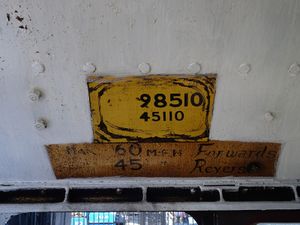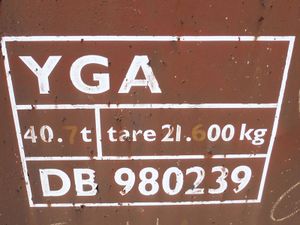TOPS codes
BR introduced the American TOPS (Total Operations Processing System) system for managing rolling stock in the late 1960s. Under TOPS, every item of rolling stock was required to have a unique ID and and was allocated a classification code.
Contents
TOPS classification
TOPS locomotive classification and numbering
BR steam had finished before the introduction of TOPS. BR Diesel locomotives were allocated numbers forming the unique ID in the form xxyyy, with xx being the class and yyy one of up to 999 members of it, for example 50031 Hood would have been the 31st Class 50 locomotive while in service.
Heritage diesel locomotives working on the main line are allocated numbers in the 89yyy series. Generally the third digit represents the power classification and the final two digits are the last two digits of the pre-TOPS number, except where duplication occurs. TOPS numbers allocated to SVR locomotives include:[1]
- 89413: D1013 Western Ranger
- 89416: D1015 Western Champion
- 89421: D821 Greyhound
- 89431: 50031 Hood
- 89444: 50044 Exeter
- 89449: 50049 Defiance
- 89462: D1062 Western Courier
- 98150: 1450
- 98186: 686 The Lady Armaghdale
- 98243: 46443
- 98406: 43106
- 98425: 7325
- 98469: 75069
- 98479: 80079
- 98502: 7802 Bradley Manor
- 98510: 45110
- 98512: 7812 Erlestoke Manor
- 98519: 7819 Hinton Manor
- 98530: 4930 Hagley Hall
- 98560: 6960 Raveningham Hall
- 98568: 42968
- 98727: 34027 Taw Valley
- 98857: 2857
- 98873: 48773
For heritage locomotives, the TOPS number was used for reporting purposes and was commonly displayed inside the cab.
Heritage carriages used on the main line are allocated numbers in the 99yyy series. The SVR's GWR main line set were allocated the following TOPS numbers:[3]
- 99230: GWR 5883 Brake Third
- 99231: GWR 1116 Full Third
- 99232: GWR 1146 Full Third
- 99233: GWR 9631 'Clapham' Buffet Car ( No longer resident)
- 99234: GWR 1086 Full Third
- 99235: GWR 1087 Full Third
- 99236: GWR 7284 Composite
- 99237: GWR 9627 Restaurant Third
- 99238: GWR 6562 Brake Composite
- 99239: GWR Full Third 2119
- 99730: GWR 9615 Kitchen Diner First
TOPS carriage and wagon classification codes
TOPS classifications were applied to all carriages and wagons and recorded in a field called CARKND. For most rolling stock the classification comprises three letters, the first letter indicating the broad type, the second letter giving more detailed information of that type (different for each series) and a suffix giving the braking arrangements. The last was an important aid to marshalling trains at a time when BR had a mixture of air, vacuum and other braking arrangements.[4]
Passenger carrying stock (type A) included a digit after the first two letters to specify the class of passenger accommodation (1=First, 2=Second, later Standard, 3=Composite, 4=Unclassified, 5=None). The suffix indicated the build rather than the braking arrangement (1=Mk 1, Z=Mk 2, A=Mk 2a, etc.)[5]
Examples of the main classification codes (first letter) after 1984 were:
- A: Hauled passenger carriages
- B: Bogie Steel wagons
- C: Covered bulk wagons (except CA: goods brake vans)
- D: Diesel Multiple Unit carriages
- F: Flat wagons
- H: Hopper wagons
- M: Mineral wagons
- N: Hauled non-passenger carriages
- O: Open wagons
- Q: Hauled departmental (non-revenue) carriages
- S: 2-axle steel wagons
- T: Tank wagons
- V: Vans
- W: Flat wagons
- Y: Departmental bogie wagons
- Z: Departmental two-axle vehicle (carriage or wagon)
Examples of braking codes (third letter) were:
- A: Air brake only
- B: Air brake plus through vacuum pipe
- O: Unfitted (handbrake only)
- P: Unfitted with through vacuum pipe
- Q: Unfitted with through air pipe
- V: Vacuum brake only
- W: Vacuum brake plus through air pipe
- X: Dual brake (air and vacuum)
SVR rolling stock with TOPS classification codes
Note: Most of the GWR / LNER / LMS era rolling stock had been withdrawn by the time TOPS was introduced in the late 1960s and would therefore not have received TOPS classification codes. Later SVR rolling stock with TOPS classification codes includes:
Carriages
| TOPS classification | Description | Examples |
|---|---|---|
| Mk 1 Passenger carrying stock (prefix A) | ||
| AA21 | Corridor second |
Operational: 25346, 25498, 25771 |
| AA31 | Corridor composite | 16169, 16202, 16267 |
| AB21 | Brake corridor standard | 34562, 34606, 34754, 35219 |
| AB31 | Brake corridor composite | 21254 |
| AC21 | Tourist standard open | 4345, 4399, 4505, |
| AD11 | First open | 3083, 3103, 3109 |
| AE21 | Brake standard open | 9220 |
| AJ41 | Restaurant Buffet | 1667, 1682 |
| AN21 | Restaurant Miniature Buffet | 1853, 1855, 1856 |
| Mk 1 Non-Passenger carrying stock (prefix N) | ||
| NAV | Brake gangwayed | 80776, 81013 |
| NJV | GUV (ETH wired) | 94157, 94200 (as built) |
| NKA | GUV (BRUTE) | 94157, 94200 (as rebuilt) |
| NKV | GUV (BRUTE) | 86105, 95154 (as built) |
| NNX | Courier Van with dual Vacuum / Air braking | 80222 |
| NOx | GUV 100mph | 95154 (as rebuilt) |
Wagons
| TOPS classification | Description | Examples |
|---|---|---|
| Private-Owner Bogie Wagons (prefix J) (from 1990) | ||
| JGV | Bogie Limestone Hopper (TOPS code PHV before 1990) | ICI 19052, ICI 19129 |
| Mineral wagons (prefix M) | ||
| MCO | 16t Open Mineral Wagon (unfitted) | 118443, 257698 |
| Vans (prefix V) | ||
| VAA | 29t Vanfit (full length doors, ventilated), air braked | 200176 |
| VCV | Cattle van, vacuum braked | 891054 |
| VDA | 29t Vanfit, air braked | 201056 |
| Exceptional and Special Purpose Vehicles (prefix X) | ||
| XDV | FLAT ED | 906811, 906825, 906830 |
| Bogie Departmental Wagons (prefix Y) | ||
| YGA/YGB | 'Seacow' Bogie Ballast Hopper | 6 x Seacows |
| YLO | 'Gane A' Bogie Rail Wagon | 996730 |
| YNO | ‘Prawn’ Borail/Bolster Wagon | 997623 |
| YQA | 'Parr' Bogie Rail Wagon | 967526, 967577 |
| 2-axle Departmental Wagons (prefix Z) | ||
| ZBA | ‘Rudd’ (also Carp/Hake) Ballast Open | 15 x Rudds |
| ZCO | ‘Tunny’ (and other) Ballast/Sleeper Open | 991124 |
| ZFV | 'Dogfish' Ballast Hopper | 983115 |
| ZJV | ‘Mermaid’ Side-Tipping Ballast Wagon | 989098 |
| ZMV | ‘Mackerel’ Ballast Hopper | 992329 |
| ZUB | ‘Shark’ Ballast Plough Brake Van (Vac fitted) | 993876 |
| ZUV | ‘Shark’ Ballast Plough Brake Van (Air braked) | 993898 |
TOPS location codes
- 65941 Kidderminster Severn Valley Railway[6]
- 65942 Kidderminster Severn Valley Railway Diesel Depot
See also
References
- ↑ RCTS TOPS Class 89 listing
- ↑ RCTS TOPS class 98 listing
- ↑ Railway Heritage Register Carriage Survey
- ↑ Wikipedia
- ↑ Longworth (2013) pp. 7-8.
- ↑ Location Codes on www.railwaycodes.org.uk
Links
- Wikipedia: TOPS
- Wikipedia: British Rail locomotive and multiple unit numbering and classification
- Wikipedia: British carriage and wagon numbering and classification
- RCTS: Class 89 TOPS listing
- RCTS: Class 98 TOPS listing
- LTSV Wagons: Wagon TOPS listing

